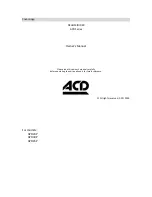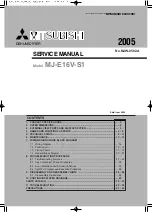
13
EN
shall be taken is case analysis is required prior to re-use of reclaimed refrigerant. It is
essential that electrical power is available before the task is commenced.
a) become familiar with the equipment and its operation.
b) Isolate system electrically.
c) Before attempting the procedure ensure that;
Mechanical handling equipment is available and being used correctly; the recovery
process is supervised at all times by a competent person; recovery equipment and
cylinders conform to the appropriate standards.
d) Pump down refrigerant system, if possible.
e) If a vacuum is not possible , make a manifold so that refrigerant can be removed from
various parts of the system.
f) Make sure that cylinder is situated on the scales before recovery takes place.
g) Start the recovery machine and operate in accordance with manufacturer’s
instructions.
h) Do not overfill cylinders. (No more than 80% volume liquid charge).
i) Do not exceed the maximum working pressure of the cylinder, even temporarily.
j) When the cylinders have been filled correctly and the process completed, make sure
that the cylinders and the equipment are removed from site promptly and all isolation
valves on the equipment are closed off.
k) Recovered refrigerant shall not be charged into another refrigeration system unless it
has been cleaned and checked.
15. Labeling
Equipment shall be labeled stating that it has been de-commissioned and emptied of
refrigerant. The label shall be dated and signed. Ensure that there are labels on the
equipment stating the equipment contains flammable refrigerant.
16. Recovery
When removing refrigerant from a system, either for servicing or decommissioning,
it is recommended good practice that all refrigerant into cylinders, ensure that only
appropriate refrigerant recovery cylinders are employed. Ensure that the correct number
of cylinders for holding the total system charge are available. All cylinders to be used
are designated for the recovered refrigerant and labeled for that refrigerant(i.e special
cylinders for the recovery of refrigerant). Cylinders shall be complete with pressure relief
valve and associated shut-off valves in good working order. Empty recovery cylinders are
evacuated and , if possible, cooled before recovery occurs.
The recovery equipment shall be in good working order with a set with a set of
instructions concerning the equipment that is at hand and shall be suitable for the
recovery of flammable refrigerants.
In addition, a set of calibrated weighing scales shall be available and in good working
order. Hoses shall be complete with leak-free disconnect couplings and good condition.
Before using the recovery machine, check that it is in satisfactory working order, has been
properly maintained and that any associated electrical components are sealed to prevent
ignition in the event of a refrigerant release. Consult manufacturer of in doubt.
The recovered refrigerant shall be returned to the refrigerant supplier in the correct
recovery cylinder, and the relevant Waste Transfer Note arranged. Do not mix refrigerants
in recovery units and especially not in cylinders.
If compressors or compressor oils are to be removed, ensure that they have been
evacuated to an acceptable level to make certain that flammable refrigerant does not
remain within the lubricant. The evacuation process shall be carried out prior to returning
the compressor to the suppliers. Only electric heating to the compressor body shall be
employed to accelerate this process. When oil drained form a system, it shall be carried
out safely.
Summary of Contents for PWR-50L
Page 1: ...MODEL PWR 50L USER S MANUAL MANUAL UTILIZATORULUI ENGLISH ROMANA DEHUMIDIFIER...
Page 2: ...2...
Page 3: ...3 EN LANGUAGES ENGLISH 3 27 ROMANA 52...
Page 27: ...27 GR Power 1 28 2 31 3 R290 R32 32 4 38 5 40 6 41 7 44 8 46 9 46 10 47...
Page 28: ...28 GR 1 l l...
Page 29: ...29 GR 8...
Page 30: ...30 GR 1 l...
Page 31: ...31 GR l PCB T 3 15A 250V 350V CO2 24 2 l 2002 96 EC 27 2003 l CO2 l A B...
Page 32: ...32 GR 3 R290 R32 4m2 R32 R290 R32 290...
Page 33: ...33 GR R290 R32 1 2 3 4 5 6 1 2 3 4 5 CO2 6...
Page 34: ...34 GR 7 8 9 7...
Page 35: ...35 GR 8 9 10 11 O LFL 25 12...
Page 36: ...36 GR 13 14 80...
Page 37: ...37 GR 15 16...
Page 38: ...38 GR A 4 SN D2002255780115715200209 SN D2002255780115715200209 SN...
Page 39: ...39 GR 1 40cm 2 5 C 5 C 3 4 2 5...
Page 40: ...40 GR 5 4...
Page 43: ...43 GR FILTER FILTER FILTER 250 FILTER...
Page 44: ...44 GR 7 1 P2 P2 2...
Page 45: ...45 GR x...
Page 46: ...46 GR 15 8 l M l 2 9 24...
Page 47: ...47 GR 10 HEPA 45 55...
Page 48: ...48 GR Mode Cont Comfort Cont Comfort 3 l l l l l l l l l l l...
Page 49: ...49 GR l l l l l l l l l l l l AS ES EC EC 3 P2...
Page 50: ...50 GR 211 300 3300 www inventoraircondition gr media library...
Page 76: ...DEHUMIDIFIER v 1 0...














































